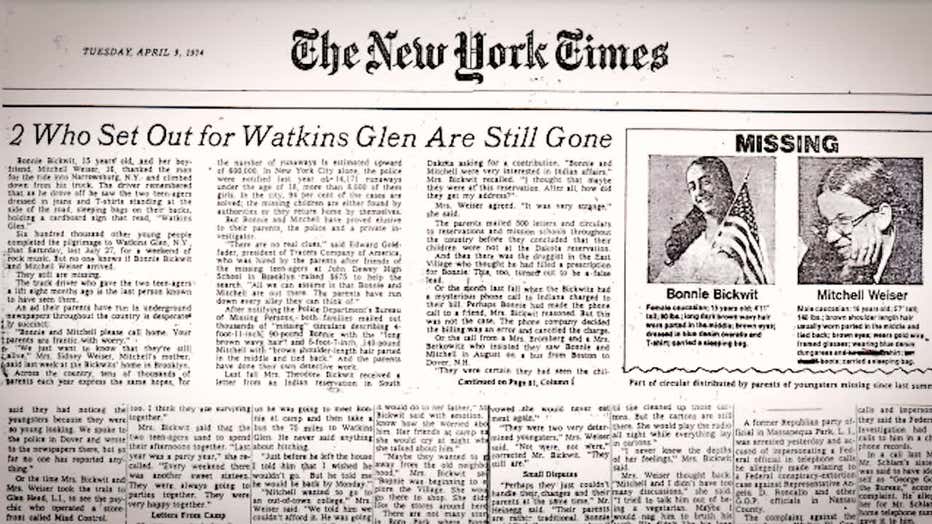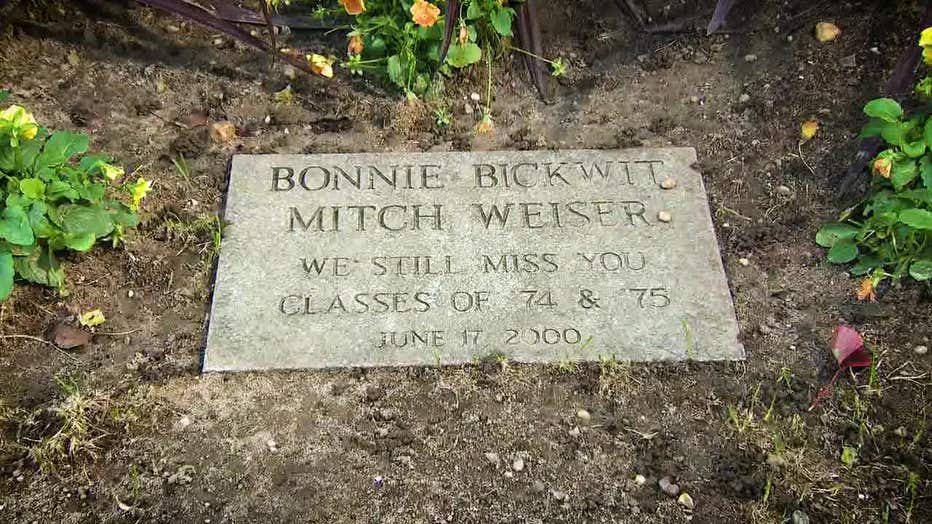The Tape Room: 1973 NYC cold case involving missing teens resurfaces
The Tape Room - 1973 cold case resurfaces
A cold case from 1973, when Brooklyn teens Mitchel Weiser and Bonnie Bickwit vanished while hitchhiking to the Summer Jam concert at Watkins Glen is back in the headlines.
BROOKLYN - In July 1973, Brooklyn natives Mitchel Weiser and Bonnie Bickwit vanished while hitchhiking to the Summer Jam concert at Watkins Glen, a festival that made history with over 600,000 attendees, but ended in heartbreak for two Brooklyn families.
Fifty years later, the mystery of what happened to these teenagers lingers, and it's considered one of the oldest "Missing Teen" cases in United States history.
"Where did they go? What happened to them? That's the answer we've been searching for for 50 years," Michelle Fester Weller, a close friend of Bonnie, reflects on the enduring mystery. "That year when that happened, the world changed for everybody. Because before that the world was carefree, loving, safe. And that year, the world changed for everybody. Because of that situation, we had never heard of anything like that."
What happened to the Brooklyn teens?
The two had embarked on a journey with just $25, backpacks, sleeping bags, and a cardboard sign that read "Watkins Glen." Mitchel took the bus from Port Authority to meet Bonnie at Camp Wel-Met, and they set off for the concert, which was 156 miles from Narrowsburg.

They were last seen getting a ride from a truck driver, setting them on State Route 97 towards an unknown fate.
"They meet at the camp, and then they hitchhike. They had their sign that said ‘Watkins Glen,’ and they went on the road like other kids did at the time and put their thumb out," journalist Eric Greenberg recounts, reflecting on the last known moments of the couple.

Greenberg grew up in Brooklyn at the time and remembers the case as it unfolded. In the years since, he has written about the case extensively for Rolling Stone. After his most recent article, Gov. Kathy Hochul directed state police to take a closer look at the case.
Fifty years ago, when the teens didn't come home, their parents contacted police in Sullivan County, near Watkins Glen in Schuyler County, and even the NYPD.
"We saw really nothing was happening," Fester-Weller said. "It didn't seem like the detectives were taking it seriously. They just wrote them off as two runaways. And it was sort of a helpless feeling."
Case breakthrough in 2000
Years go by, and the case eventually goes cold. Then, nearly three decades later in 2000, there was finally a break. It was a call to state police after the disappearance was highlighted in a TV report at the time.
A significant lead emerged when a Rhode Island man, Alan Smith, came forward with a chilling account. According to former NY State cold case investigator Roy Streever, Smith's testimony appeared remarkably credible in art because of the diligence he took to track down investigators.
"After numerous failed attempts to contact me he finally got through to the correct agency and, and to me, and we made arrangements to get together, he voluntarily drove from his home in Rhode Island, down to Middletown, New York," Streever said.
"He said I recognize them from the pictures that were posted on the show," Streever recounted, noting that Smith claimed to have hitchhiked with Mitch and Bonnie in an orange Volkswagen and made a stop at the Susquehanna River. The story took a dramatic turn at the river.
‘He heard a scream’
"He heard a scream, looked out at the water, and there was a young girl, obviously in trouble in the water, and her boyfriend jumped in. And also, the two of them got swept away around a bend in the river and out of his sight," Streever detailed, the potential gravity of Smith's account.

The Susquehanna River, known for its expansive flow into Pennsylvania and down into the Chesapeake Bay, became a focal point of investigation. Streever pursued this lead, consulting with coroners in the first three counties through which the river flows. Remarkably, all three coroners, who were in office since 1973, reported that no unidentified bodies had ever surfaced in their counties.
But the plausibility of the story was enough for some family and friends to accept as closure, but not everyone.

As the decades have passed, the original investigation has faced criticism, with Mitchel's best friend, Stuart Karten, maintaining a website devoted to the couple in hopes of uncovering new leads.
"It was kind of botched from the beginning, and kind of just got pushed along. And nobody ever really took it seriously," Karten said, echoing the sentiments of those who have longed for answers.
Who is Robert Garrow?
Now, after all these years there is a new clue unvovered by journalist Eric Greenberg. It's a link to Robert Garrow, a convicted serial rapist and murderer active in upstate New York during the early 1970s.

"There was a serial killer in upstate New York at that very time, Robert Garrow," Greenberg said. It turns out, Garrow, known for his brutal crimes specifically targetting young people, drove an orange Volkswagen, identical to the vehicle described by Smith.

"He had killed a girl, raped a couple of other girls, and he was driving an orange Volkswagen, and no one ever put that together before. Now is a good time for the state police to actually look into this," Greenberg suggested, implying a possible connection between Garrow and the mysterious disappearance of the teenagers.
Garrow was later shot dead while escaping from prison in 1978.
What's next?
As the case unfolds with these new insights, the question remains: did the secret of what happened to Mitchel Weiser and Bonnie Bickwit die with Garrow, or is there more to uncover?
Criticism has also been directed toward the Sullivan County Sheriff's Office regarding their response. In defense, the Sheriff’s Office states, "The Sullivan County Sheriff’s Office has worked on the missing persons case of Bonnie Bickwit and Mitchel Weiser for over 50 years. Sheriff’s detectives followed numerous leads during the 2010s, working with the NY State Police BCI in Troop E, the Steuben County Sheriff’s Office as well as the National Center for Missing and Exploited Children and other allied agencies. Sheriff’s detectives and their colleagues have spent thousands of hours conducting interviews, deploying search teams, utilizing cadaver dogs, excavators, and even jackhammered the concrete stairs of a residence at a suspected location."
Now, with renewed attention and the possibility of new leads, there is a collective desire for closure
"I think it's about time that we have some closure, whatever the closure is, if it's, you know, a bad ending or a positive ending, we need closure. And I think it's about time that we got it," Fester Weller stated, capturing the hope that persists even after half a century of mystery.

